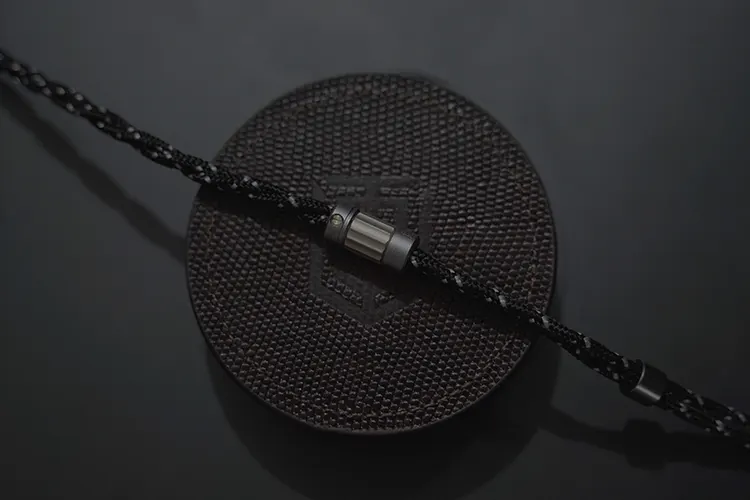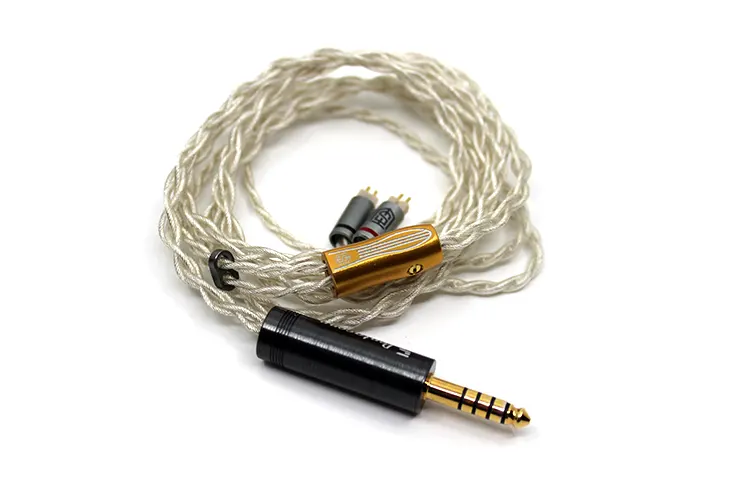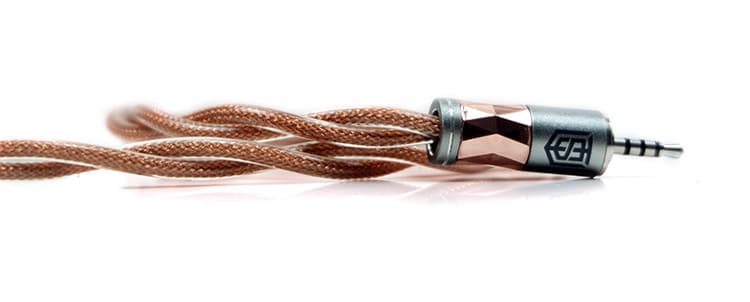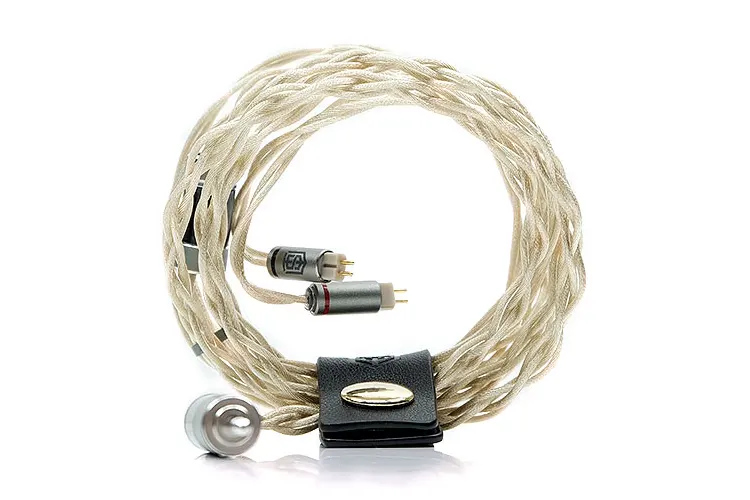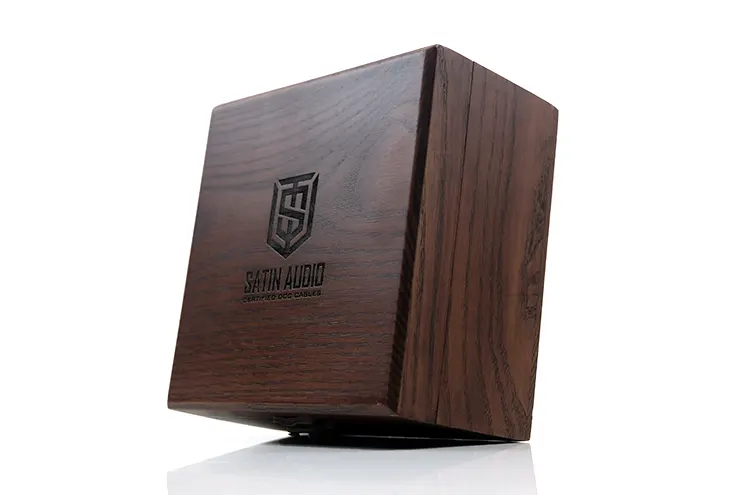Select Comparisons
The following comparisons to the Satin Audio Hera were completed using a mix of the HiBy R8 II and the Luxury & Precision P6 Pro as my main sources. For IEMs, I used the Vision Ears VE10, SWEEAR’s SR11, and the 64 Audio Volur.
Satin Audio Apollo
The Satin Audio Apollo was launched in early 2023 and reviewed by Josh around the same time. Like the Hera, the Apollo is also part of the company’s high-end Olympus range.
Technical
There is some overlap between these cables as both use the Satin Structures II Geōmetria multi-sized stranded geometry including Satin Audio’s advanced “SA Insulation II” jacket.
They also come in a default 4-wire size though the Apollo options include 6, 8, and 12 direct from their website checkout. fear not, the Hera can be bought as an 8-wire if you email a request beforehand.
The wire gauge is also similar with both cables using the new 26AWG+ rating and each cable has a Kevlar damping core in the center.
For plugs and connectors similar options exist for each cable with both of my samples using the 2-Pin TeCu/PEEK and MMCX TeCu/Teflon connectors and the Ultimate Copper 4.4mm Pentaconn plug.
The big difference internally is the choice of wire materials. The Apollo uses a palladium-plated gold-silver mix with superior pure OCC silver. The Hera flips it a little and gets even more complex with palladium-plated silver-gold OCC, an SP-OCC silver-gold alloy, palladium-plated silver, and pure OCC silver.
Design
The Apollo’s aesthetics and handling are quite different compared to the Hera. The Apollo uses a tighter transparent TPU-type braided jacket creating a much thinner form factor and a brighter aesthetic with the internal wiring clear to the eye.
The Hera’s fabric jacket creates a much darker profile, even with the speckled white accents. The twister fabric outer finish also creates a thicker form factor so it looks the bulkier of the two cables but the weight difference is negligible.
I will say though the Hera is the softer of the two jackets in the hand and unlikely to suffer long-term hardening which can happen to tighter older PVC-type jackets over time.
The one weakness is those memory sheaths on the Hera. Both use the same sheaths but visually they are more blended on the Apollo whereas they seem to stick out like a sore thumb on the black fabric of the Hera jacket.
Also, due to the larger form factor, the angle is sharper on the Hera sheath giving it a slightly less comfortable feel.
The finishing on the plugs and connectors are an exact match but they diverge on the splitter choices. The Apollo’s lyre-shaped gold finish is a bit more unique with the Hera pillar version a bit more conservative though with some very accurate cutting.
Performance
This was a tricky comparison because there were many differences but of a subtle nature rather than vastly different.
The changes were more easily identifiable with more sensitive dynamic driver hybrid models such as the VE10 rather than higher impedance BA monitors. However, once I managed to pin them down I could pick them out better on IEMs such as the Nostalgia Audio Tesseract.
The best analogy I could start with is moving from the Apollo to the Hera is akin to moving from a class AB transistor amp to a SETA tube amplifier in terms of tonal characteristics with the VE10.
Neither is overtly clean or neutral sounding but the Apollo is the tighter and more holographic of the two with improved instrumental separation and a slightly shorter level of note decay. Of the two the Apollo/VE10 had the more accurate harmonic balance.
The Hera is more grandiose in its presentation, spreading things a bit wider, with more sparkle but also more low-end bloom on the lows and a slightly stronger sub-bass presence from the VE10.
There is more warmth in this pairing’s presentation, and a bit less instrumental separation and complexity. However, I enjoyed the fuller, more euphonic vocal overtone with higher-pitched singers.
If you are after accuracy and timing with a little more clarity and evenness in the presentation then the Apollo is the better pick. If you are after a more effusive joyful presentation, and dare I say a creamier more analog vibe to the VE10 performance, then the Hera is a suitable pairing.
Satin Audio Perseus
The Satin Audio Perseus was launched in mid-2022 and priced a little bit cheaper than the Hera. It is the only cable classified under the company’s Warrior Series of cables to date.
Technical
A very different cable inside and outside compared to the Hera. The Perseus is a 2-wire construction comprised of SP-OCC grade pure copper wire.
The Hera is much more complex with its palladium-plated silver-gold OCC, an SP-OCC silver-gold alloy, palladium-plated silver, and pure OCC silver composition.
There is also a contrast with each cable’s respective wire gauging size with the Perseus using a mix of 23AWG and regular 26AWG instead of the Hera’s 26AWG+. The best way to think of how they are put together is like a wrap with the 26AWG on the inside and the larger 23AWG on the outside.
Perhaps the most tangible difference is Perseus’s coaxial geometry which Satin Audio calls a Geōmetria dual layer structure.
Perseus has a copper thread inner core, (26AWG), in a Type 1 Litz that is twisted with a fairly typical Kevlar damping core for stability purposes. Then on the outside, you have another copper thread, (23AWG), in a braided layer as your outer core.
What that means to you, the user, is that the Perseus is a fairly beefy cable per core and less malleable compared to the Hera’s more flexible geometric structure.
Design
That last sentence above provides a nice segway into the design difference with the handling one of the more noticeable differences.
Both of these cables are twisted finishes but the Hera’s lighter geometry and softer fabric jacket make it by far the more comfortable and pliant of the two 1.2m cables. The Perseus is firmer and stiffer, making it significantly less manageable.
However, Perseus’s aesthetics and visual pop are superior. Not that it uses significantly better barrels, plugs, and connectors but rather the coppery theme is infused throughout the design giving it a very harmonious look.
Technically, the barrel form factor choices for the splitter are the same for both cables with the central column design bringing the main difference with again, that more harmonious copper finishing.
The Hera is unique by being the only fabric jacket cable in the range but it still has a more understated color scheme. The barrels are of different designs so it is not quite as complementary but still quite nice looking.
Performance
I used the VE10 and the Sr11 for this comparison and with both pairings, the Hera sounded the more vibrant of the two cables with the Perseus delivering a denser weightier tone.
One thing that did stand out, especially on the SR11, is the stronger mids to treble presence from the Hera with the Perseus a little more attenuated from the upper mids onwards.
A few knock-on effects from that observation. The stronger treble presence from the Hera pairing does help to flesh out the perception of an airier, taller, and wider soundstage from the SR11 whereas the Perseus staging gets a little narrower and darker through the mids and highs.
In return, the power and solidity of both the low-end and some lower-pitching instruments and vocals improve on the Perseus.
Side by side, you could argue that Hera has a slightly lighter note in general with a slight increase in tonal contrast and a shade less low-end weight. It brings a stronger sense of energy and vibrancy to the performance of the SR11 compared to the calmer performance of the Perseus pairing.
Neither is what you would call neutral but if you want something with a better eye for detail the Hera does seem to deliver more information than the Perseus, particularly through the highs and higher pitching percussion which sounds more truncated from the Perseus pairing.
Satin Audio Zeus
Reviewed in 2020, the Satin Audio Zeus is the elder statesman of the compared cables in this review. However, it is still the flagship Olympus Range cable from the company at the time of writing.
Technical
So much of what is inside the Zeus inspires how Satin Audio designed the Hera.
For a start, both are default 4-wire builds using Satin Special Structures II geometry which debuted with the Zeus. They also use the same Geōmetria Multi-sized Stranded layering technique with a Kevlar central fiber core.
Where they differ is in the wire choices and the gauge size. The Zeus uses a mix of gold-plated silver, palladium-plated silver, and silver-gold alloy.
This seems slightly less complex compared to Hera’s 4 differing blends but the wires chosen have a larger 24AWG gauge wire compared to Hera’s AWG26+ and ideally should provide a bit more dynamic range and a lower level of resistance.
Both the connectors and plugs of the Hera and the Zeus are identical. That means SA palladium-plated Ultimate Copper 2.5mm/3.5mm and Pentaconn OFC 4.4mm as standard depending on your choice at the website checkout.
Design
Whilst I do not find the Hera to be noticeably heavier than the Zeus it has a thicker form factor with that twisted fabric finish.
That said, the jacket is much softer compared to my aged Zeus transparent TPU-type braided jacket. Neither cable has any issues with microphonics and offers a very low memory retentive handling capability.
The Zeus does not use any memory coating near the connectors which is a plus for my preferences. The Hera options might have been best left out.
The lack of memory wire and internalizing the strain relief on the Zeus does help keep a lot of unwanted or uneven pressure off the ear. It also keeps the profile low enough to work quite well with glasses.
Aesthetically, it’s a mixed bag. I do like the off-white sparkle of the Zeus wiring behind that transparent jacket but the barrels on my sample are old-school.
I did check the website to see if they have updated that old carbon-printed splitter and plug barrel and indeed they have. You now get a beautiful two-tone plug and splitter that nicely compliments the wiring color. The 4.4mm plug is now also the same darker Pentaconn plug that the Hera uses.
Performance
The gauge gap between the two cables didn’t produce vastly different volume levels which I might have expected given the lower resistance from the Zeus.
However, what it did bring was superior dynamic range and you could pick that up with the clearer instrumental separation and superior bass layering from the likes of the VE10 and the Volur.
Again, it’s a similar aspect from the Apollo, that tightness to the bass decay only this time the Zeus brings a better sub-bass response with it so it reaches deeper than the Hera and you can hear that power, particularly with EDM and modern R’n’B recordings.
What I do love about the Hera though is that creamy almost euphoric presentation of the mids and vocal texture. The Zero is certainly the more refined and accurate of the two with the better micro-detail but there is no denying the euphony from the Hera performance with the likes of the VE10 is intoxicating.
Granted, the Hera pairings sounded much more colored through the mids and despite its excellent width from the VE10 and the Volur, it lacks the holographic depth and imaging accuracy of the Zeus.
I can also hear a better level of control and accuracy from the Zeus treble which does help to keep the harmonic balance in check through the mids and give what I consider a more complete performance from the tested IEMs.
The takeaway from this comparison? The Zeus is still the flagship performer but the Hera can sound really special with its creamy intoxicating vocal performances at times.
My Verdict
The Satin Audio Hera aftermarket IEM cable is a colorful and easy-on-the-ear pairing that works especially well with dynamic driver hybrid IEMs.
Vocal enthusiasts will especially enjoy Hera’s lush and euphonic presentation, particularly with IEMs that have a natural and slightly forward vocal presence.
Bass heads will not get left behind either with some noticeable bloom and sub-bass presence though it is by no means the punchiest cable combo I have heard thus far from Satin Audio.
If there are some negative points it is the slight lack of staging depth combined as well as IEMs that are already significantly mid-forward might sound overly emphasized with the Hera pairing. I would also say ditch the cable’s memory hooks or give them a darker smokier finish.
Otherwise, the Hera looks and sounds very different from what Satin Audio has produced before, perhaps their most comfortable for handling and smoothest-sounding cable finish thus far.
Satin Audio Hera Technical Specifications
- Wire Gauge: 26AWG/26AWG+
- Wire Materials: Palladium-plated Silver-Gold OCC | SP-OCC Silver-Gold Alloy | Palladium-plated Silver | Superior Pure OCC Silver
- Geometry: Geōmetria Multi-sized Stranded – Satin Special Structure II mix Satin Special Structure
- Core: Kevlar Damping Core
- Finishing: Premium SA Palladium Plated UCopper 2.5mm/3.5mm and Pentaconn OFC 4.4mm as standard plugs
- Length: 1.2m

